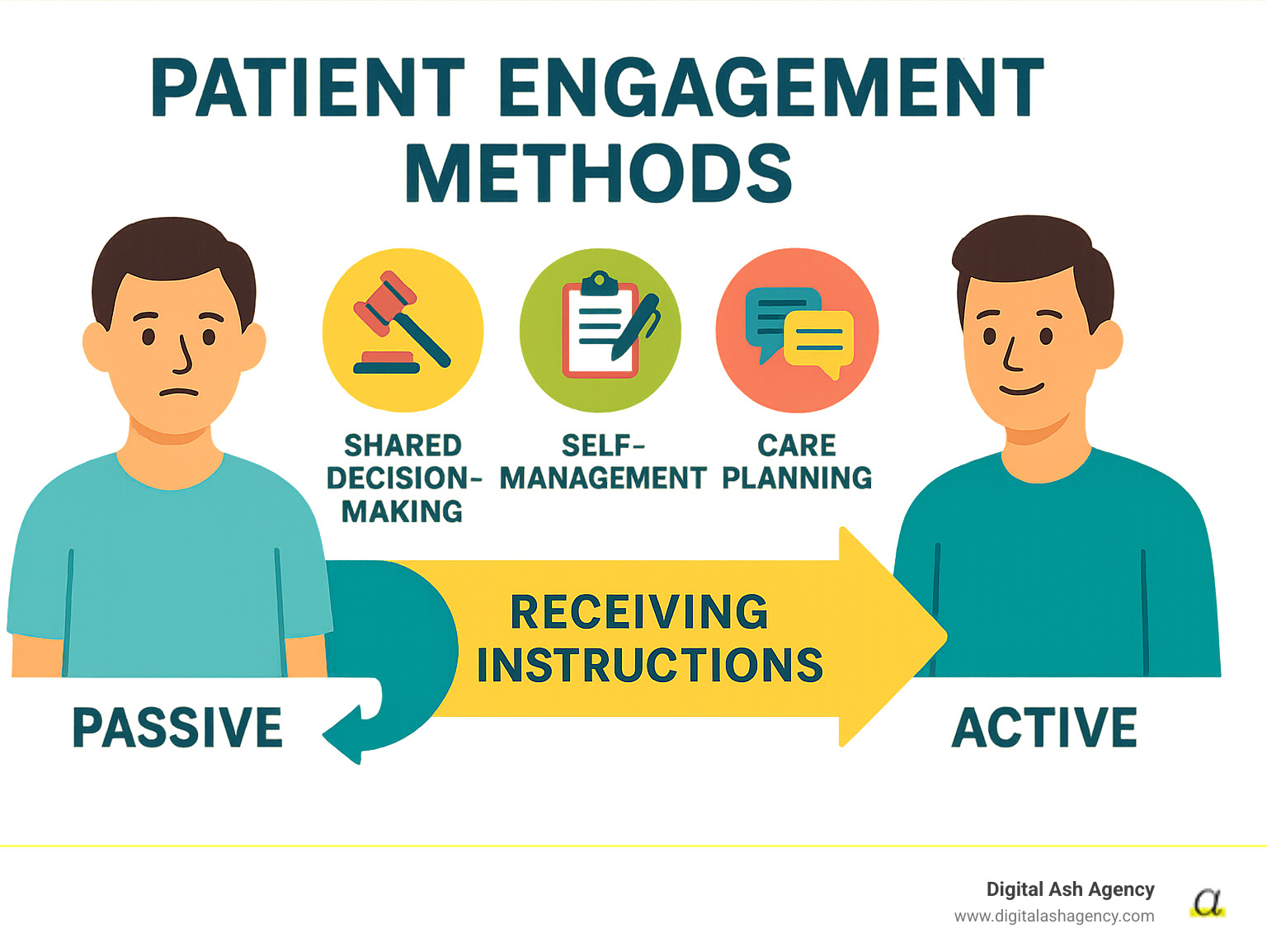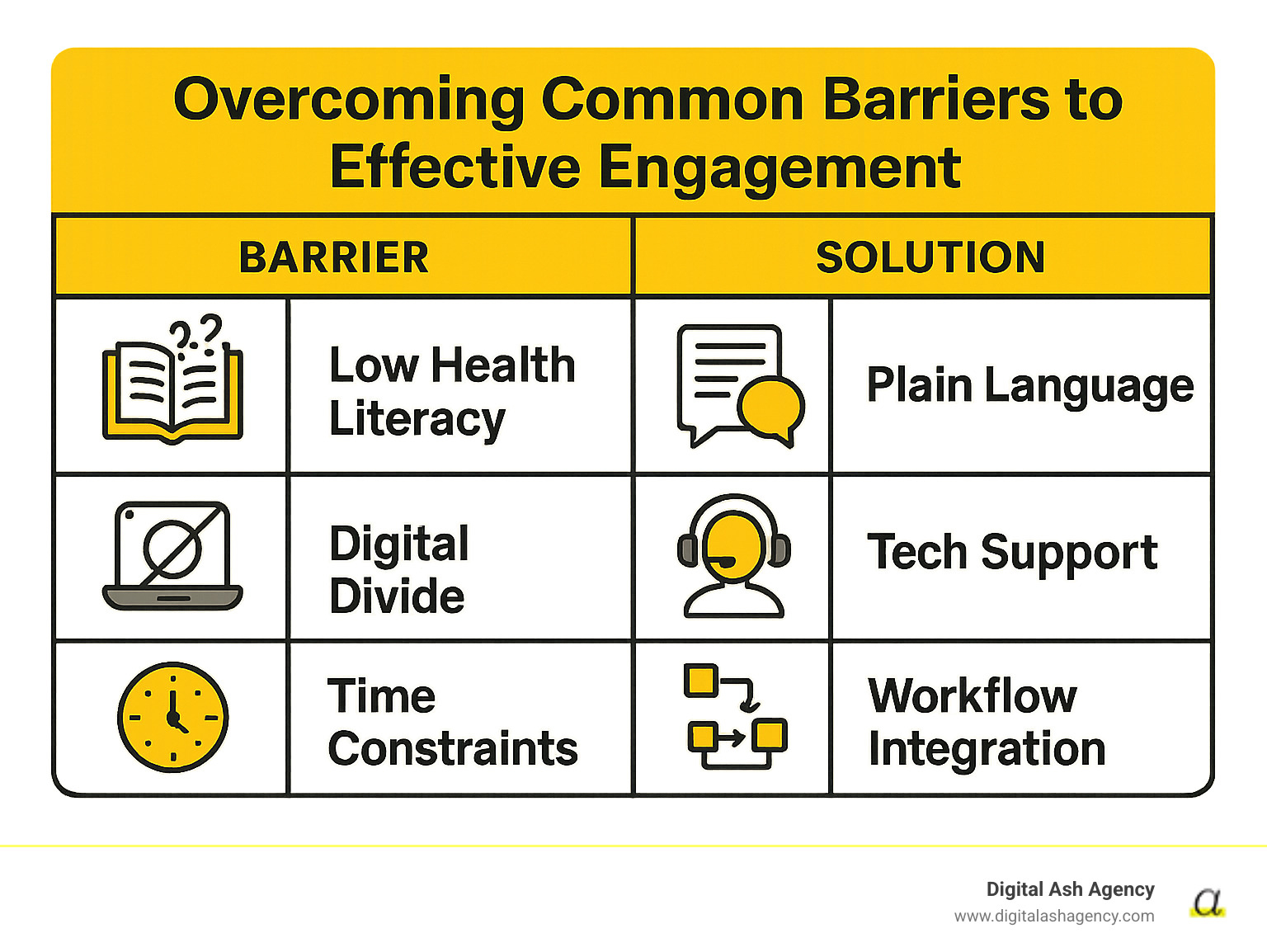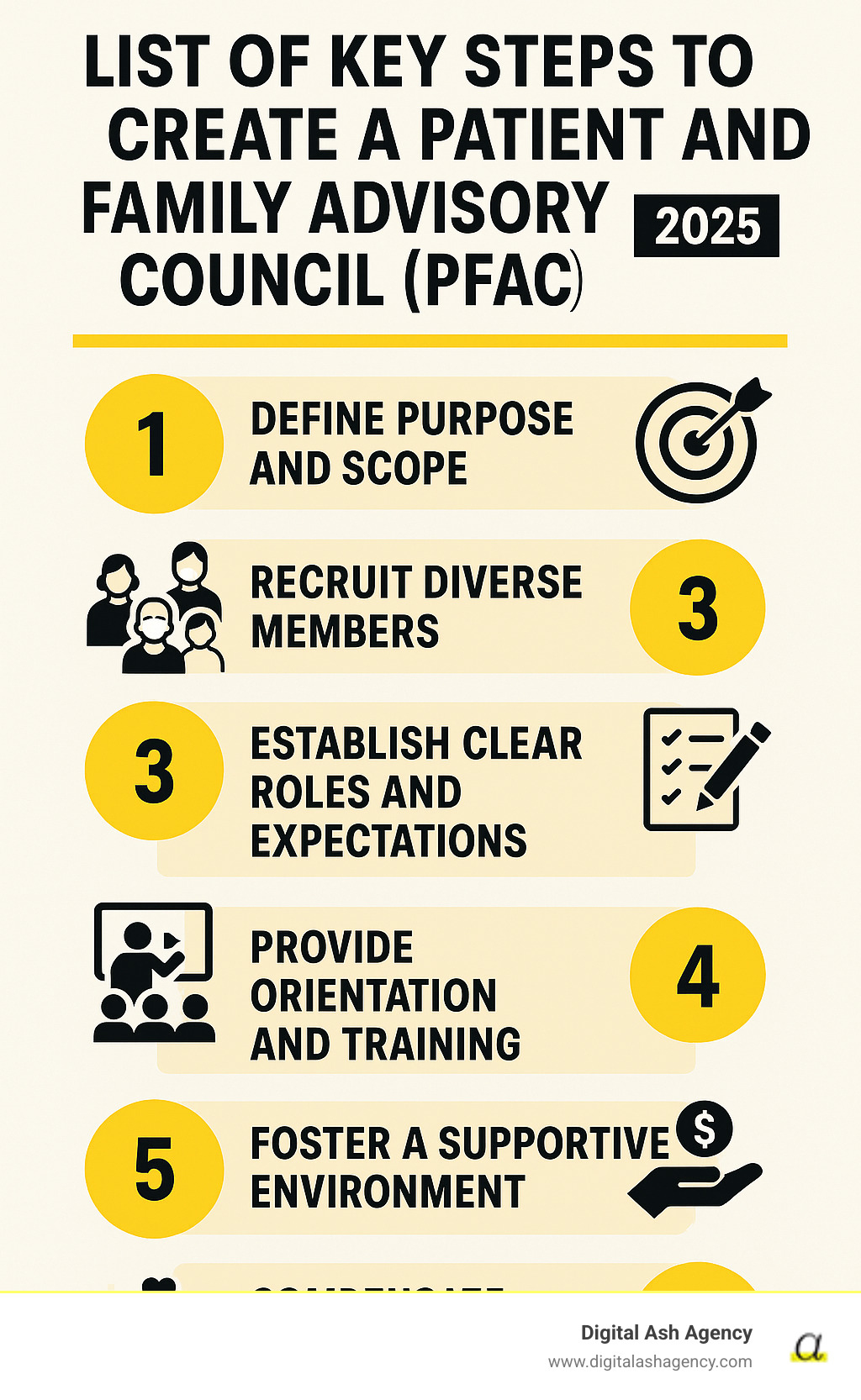
Why Patient Engagement Methods Are Critical for Modern Healthcare Success
Patient engagement methods are structured approaches that transform patients from passive recipients into active partners in their healthcare journey. This fundamental shift to a collaborative model is essential for practices looking to improve outcomes, reduce costs, and build lasting patient relationships. Key methods include clear communication, shared decision-making, technology solutions like patient portals, self-management support, and community involvement.
The need is urgent. About one third of American adults, or 89 million people, have insufficient health literacy skills, making them twice as likely to report poor health. Effective engagement gives patients the knowledge, skills, and motivation to participate in their care decisions, directly combating this issue.
As someone who helped build a medical practice that reached nearly $1 million in its first year, I've seen how patient engagement methods differentiate a practice. Creating genuine connections through strategic engagement turns patients into your best advocates and referral sources, driving both loyalty and growth.

The Transformative Benefits of Robust Patient Engagement
When providers adopt patient engagement methods, the entire healthcare experience transforms. This partnership delivers measurable improvements in health outcomes, patient satisfaction, and the practice's bottom line. The evidence is clear: active patients lead to better results for everyone.

Engaged patients are more likely to adhere to treatment plans, attend preventive screenings, and manage their health proactively. This shift is a cornerstone of high-quality, patient-centered care, a principle strongly supported by U.S. health organizations like the Agency for Healthcare Research and Quality (AHRQ).
For Patients: Empowerment and Better Health
Engagement empowers patients with the tools and confidence to manage their health. This leads to improved health outcomes, as they follow treatment plans more consistently and catch problems early. Patients develop better self-management skills for chronic conditions, gain increased knowledge and confidence in their care, and report greater satisfaction because they feel heard and respected.
For Providers and Systems: Efficiency and Quality
For practices, the benefits are tangible. Engagement drives higher patient retention, as patients who feel valued are more loyal. It can lead to reduced provider burnout by shifting some responsibility to the patient and fostering more collaborative interactions. Engaged patients make smarter healthcare decisions, resulting in more efficient resource use and lower costs of care; one U.S. study found that patients with the lowest levels of engagement had care costs up to 21% higher than those who were highly engaged. Finally, strong engagement helps practices meet value-based care goals, qualifying them for better reimbursement rates from programs that require patient participation.
A Spectrum of Involvement: Core Patient Engagement Methods
Patient engagement methods exist on a spectrum, from simple consultation to full partnership. This flexibility allows you to meet patients where they are. The levels range from consultation (gathering input), to collaboration (working together on care decisions), to partnership (involving patients in designing care), and finally to shared leadership (patient-led initiatives). The Chronic Care Model is a great example of this in action, emphasizing collaboration and self-management support.

Communication and Education Strategies
Effective communication is the foundation of engagement. Key strategies include using plain language to avoid confusing jargon, employing the teach-back method to confirm understanding (e.g., "Can you tell me how you'll take this new medication?"), and using motivational interviewing to help patients find their own reasons for behavior change. Given that many adults have low health literacy, providing health literacy support with accessible, multi-format information is crucial. It's also vital to be addressing social determinants of health, as factors like income and transportation directly impact a patient's ability to engage.
Shared Decision-Making in Practice
Shared decision-making merges clinical expertise with patient values, especially when multiple treatment options exist. Use decision aids (brochures, videos) to present unbiased information, and be transparent when discussing risks and benefits in relatable terms. The goal is aligning treatment with patient values by asking what matters most to them. This leads to setting mutual health goals and creating a collaborative plan. Programs like OpenNotes, which give patients access to their clinical notes, further promote transparency and empower patients.
Effective Patient Engagement Methods for Self-Management
For patients with chronic conditions, self-management is key. Develop personalized care plans that fit the patient's lifestyle and goals. Health coaching offers structured support and accountability, while peer support groups provide the power of shared experience. To ensure you're tracking what matters to the patient, use patient-reported outcome measures (PROMs) that capture symptoms and quality of life. Finally, use action planning to break down large goals into small, manageable steps, building momentum and confidence.
Leveraging Technology to Improve Patient Connections
Technology has revolutionized patient engagement methods, shifting interactions from the clinic to the digital world. Today's patients expect 24/7 convenience, and Health IT provides the foundation to meet that demand by breaking down barriers of time and distance. Digital tools improve accessibility, streamline data sharing, and empower patients to manage their care from anywhere.

The Power of Patient Portals and EHRs
Patient portals are the digital front door to your practice. They empower patients with tools for secure messaging (eliminating phone tag), online appointment scheduling, easy access to health records and lab results, and convenient prescription refills. These features give patients more control and reduce administrative burdens on staff. For guidance on maximizing portal use, the HealthIT.gov Patient Engagement Playbook is an excellent resource for optimizing your digital patient engagement methods.
Telehealth and Remote Monitoring
Telehealth is now a cornerstone of modern care, extending your practice's reach. Virtual visits are ideal for follow-ups and managing minor concerns, saving time for both patients and providers. For chronic disease management, telehealth and remote patient monitoring (RPM) create consistent touchpoints between visits, allowing providers to track vital signs and other metrics from patients' homes. By integrating data from wearable devices and RPM tools, providers can proactively manage conditions, prevent complications, and reduce hospital readmissions. These technologies make healthcare more convenient, boosting long-term engagement and patient loyalty.
Overcoming Common Barriers to Effective Engagement
Implementing effective patient engagement methods requires overcoming barriers on both the provider and patient sides. Recognizing these challenges is the first step toward building a stronger foundation for partnership.

Addressing System-Level and Provider Challenges
Providers and healthcare systems often face internal problems. These include time constraints and administrative burden, a lack of training in communication techniques, and difficulties with workflow integration of new tools. Additionally, traditional reimbursement policies haven't always rewarded engagement efforts, and shifting organizational culture from a provider-centric to a patient-partner model can meet resistance. Overcoming these requires strategic planning, training, and a commitment to change from leadership.
Empowering Patients by Removing Their Problems
Patients also face significant barriers. Health literacy challenges are widespread, with research showing a strong link between low health literacy and poor outcomes. The digital divide can exclude patients without reliable internet or technology access. A lack of cultural competency from providers can erode trust, a problem compounded by a historical lack of trust in the healthcare system among some marginalized communities. Finally, financial constraints and other social determinants of health can make it impossible for patients to follow care plans, regardless of their desire to engage.
Building a Successful Partnership: Implementation and Measurement
Implementing patient engagement methods means shifting from working for patients to working with them. This partnership approach involves inviting patients to help design and improve healthcare services, often through structures like Patient and Family Advisory Councils (PFACs).

Practical Steps for Involving Patients as Partners
To move patients from feedback providers to true partners, you must be intentional. Start by defining clear roles and expectations so everyone understands their purpose and commitment. Provide onboarding and training to help patient partners feel confident and effective. Ensure fair compensation to acknowledge their valuable time and remove financial barriers to participation. Finally, create a supportive environment with plain language, accessible meetings, and a genuine openness to feedback. For excellent tools on this topic, explore the PCORI Engagement Resources.
Measuring the Impact of Your Initiatives
If you can't measure it, you can't improve it. To track the impact of your engagement efforts, use a mix of quantitative and qualitative data. Administer patient experience surveys like CAHPS to get standardized feedback and benchmark your performance. Use the Patient Activation Measure (PAM) to assess patient confidence and self-management skills. Track clinical outcomes such as medication adherence, A1c levels, and hospital readmission rates to see the health impact. Gather staff feedback to understand how new workflows are affecting your team. Finally, analyze the return on investment (ROI) by looking at metrics like reduced care costs and improved patient retention. This data creates a continuous improvement cycle for your engagement strategies.
Frequently Asked Questions about Patient Engagement Methods
As practices begin to adopt patient engagement methods, several common questions arise. Here are concise answers to the most frequent inquiries.
How do I start implementing patient engagement in a small practice?
Don't try to do everything at once. Start small by picking one area to improve, such as shared decision-making. This can be as simple as asking patients, "What matters most to you?" Use existing technology like your patient portal more effectively before investing in new tools. Most importantly, gather patient feedback regularly through simple surveys or check-ins to guide your priorities and ensure your efforts have a real impact.
What's the difference between patient engagement and patient satisfaction?
These two concepts are related but distinct. Patient satisfaction measures happiness with a service—like a customer review. It's about the patient's perception of their experience. Patient engagement is the active involvement of patients in their own care. An engaged patient participates in decisions and manages their health proactively. While engagement often leads to satisfaction, you can have a satisfied patient who is not engaged. The goal is to achieve both.
How can we engage patients from diverse backgrounds?
Inclusive engagement is essential for serving your entire community. Start with cultural competency training for your team to build understanding and trust. Provide materials in multiple languages and formats to improve accessibility. Address social determinants of health by screening for barriers like transportation or income and connecting patients with community resources. Finally, build trust through community partnerships to better understand the needs of different populations and ensure your patient engagement methods are truly inclusive.
Conclusion
Patient engagement methods are not just a best practice; they are the foundation of modern healthcare success. By changing patients into active partners through shared decision-making, technology, and personalized support, practices can achieve better health outcomes, greater patient satisfaction, and improved efficiency.
The future of healthcare is collaborative. Mastering patient engagement methods provides a powerful competitive advantage, building a loyal patient base that helps practices thrive in any market. When you create genuine partnerships, you don't just improve clinical results—you create advocates for your practice.
This is where Digital Ash Agency comes in. We understand that strong patient relationships are the heartbeat of a successful practice. Our specialized marketing and networking strategies help you build the trust and engagement that turn patients into partners. Whether you're navigating a competitive market or looking to deepen patient relationships, we can help you create the connections that matter.







